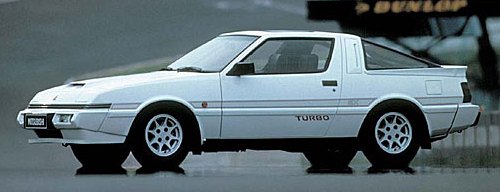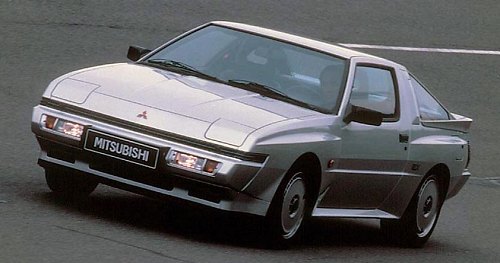 Just as the economy of
Japan, Mitsubishi was booming in the 1970s. Entering 1980s, it got the
confidence and ambition to fight against the very best of the world.
Nothing could be more encouraging than producing a world-class GT, one
would compete on equal ground with Nissan Fairlady, Toyota Supra, Mazda
RX-7 and even Porsche 924. That was the Starion.
When the Starion came out in 1982, it looked much more striking than the aging 280ZX, RX-7 Mk1 and even the newly launched Celica Supra (Celica XX). Certainly its styling was heavily influenced by Porsche 924 – just as the later 1985 RX-7 and 1986 Supra – but Mitsubishi opted for an angular and wedge interpretation so that it had a character of its own. Its pop-up headlamps and aggressive spoilers recall our wild dreams in the 1980s. Even after 30 years it still looks striking. Mechanical-wise the 2+2 GT was based on the rear-drive chassis of Galant Lambda. It got all-independent suspensions by means of MacPherson struts, ventilated disc brakes and one of the earliest applications of ABS (though worked on the rear wheels only). Even more advanced was the 2-liter 4G63 engine. Although it had only a single camshaft driving 8 valves, it featured several unusual technologies: Lancester twin-balance shafts, electronic fuel injection and a turbocharger. The former smoothed its four-cylinder vibration and the latter boosted its output to a remarkable 170 hp and 181 lbft. Mitsubishi was the pioneer of turbocharging technology in Japan (it even produced its own turbochargers). The 4G63 had already been proved powerful and reliable in Lancer EX2000 turbo. It just needed a modern shape to promote its high-tech image. The Starion fitted that purpose perfectly. With a top speed of 135 mph and 0-60 in 7.5 seconds, not even the new Porsche 944 could fend off its challenge. Of course, the Mitsubishi was significantly cheaper yet more generously equipped.  Wide-track Starion The competition got intense when the new generation 300ZX,
RX-7 and Supra arrived in the mid-1980s. The Starion also got
performance upgrade. 1985 saw the addition of limited slip differential
and an intercooler which boosted output to 180 hp and 214 lbft.
Although its claimed top speed of 143 mph was never proved, 0-60 mph
acceleration dropped to a remarkable 7.0 seconds. 1987 came a
wide-track chassis with 50 mm extension of wheel arches. The wider
tracks, revised suspension geometry and wider rear tires improved its
handling, making it far more predictable at the limit.
The wide-track body was actually applied to American export (under the badge of Chrysler Conquest) from the outset. That car also featured a larger 2.6-liter turbo engine to compensate for the lower state of tune necessitated by emission control. In Europe, the switch to unleaded fuel and catalytic converter in 1989 called for the same 2.6-liter engine. Its power dropped to 155 hp, accompanied with reduced performance. By the time the Starion was already outdated. Its place would be substituted by Eclipse and GTO after 1990. The Starion rarely came out on top in comparison tests against its rivals. Although it showed good performance, handling (at least for wide-track version) and practicality, it was criticized for old-fashioned turbo lag, which meant little punch under 3000 rpm and a surge of power thereafter. That problem would not be solved during its life. However, looking back to the car today, that turbo lag and that striking look did contribute to a sense of excitement that only existed in the 1980s performance coupes. More so than any rivals, it represented the best memory of the 1980s. |